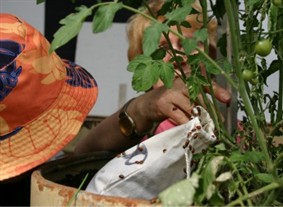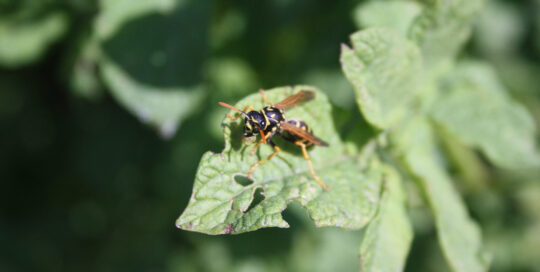The Great Ladybug Experiment
Views: 3332

There’s a local group that grows veggies in a county greenhouse for Meals on Wheels from February to November. Unfortunately, someone brought in geraniums to winter over and obviously hauled in aphids as part of the package.
It’s been a struggle to keep the aphids under control in such an ideal environment. Erin, the greenhouse guru, used insecticidal sprays; she was able to knock them back, but not knock them out.
So, I told her I would buy a box of ladybugs from Planet Natural (a place in Bozeman, not far from here) to see if they will do anything.
Ladybugs for Aphid Control
Theoretically, ladybugs (Hippodamia convergens) think aphids are absolutely yummy. Actually they think a whole lot of insects, including spider mites and thrips, are delicious, too. However, when most people release them in their gardens they see their investment fly away. I figured the enclosed environment of the greenhouse is a good test.
The problem with ladybugs is the timing of their release. Letting them go at this time of year is out of sync with their normal life cycle, but frankly, the entire atmosphere of the greenhouse is different than outside.
A few hours after the ladybugs arrived in their tiny box, the boys and I took them over to the greenhouse. Erin let them go on the most heavily infested tomato plant she had. The ladybugs crawled out and many started going right up the stems. Others flew away, but hopefully found their own bunch of aphid snacks.
Keeping Them Alive and Well
It’s been about a week, and Erin reports a lot of the ladybugs have died. It doesn’t surprise me too terribly much, but I hope there are enough to do something. My ideal situation would be if a viable population remained there for generations. If we could keep them living in there throughout the year, I think it would keep aphids at lower, if not non-existent, levels.
The one thing we need to do is to provide an additional food source. If the ladybugs are efficient, they’ll run out of food and die. There are commercial foods for ladybugs and lacewings, but I think well try our hand at making our own.
One recipe I found calls for equal parts of yeast and sugar with enough water added to make a paste. You place this schmeer on wooden stakes and set them around the plants where the ladybugs are hanging out waiting for the next meal. Other than an extra food source, I dont see a reason why they shouldnt stick around and do our dirty work for us. Time will tell.
If the ladybugs dont do the trick, we have plans B and C waiting in the wings (pardon the pun); we might try lacewings or parasitic wasps. I figure theres more than one way to take out the nasty little sapsuckers. And I would like to find some sky blue sticky traps to help snag a few of the female aphids when theyre on the move. Itll be good to see what actually works.
Meet Amy Grisak
Amy is a freelance author and photographer in Great Falls, MT who specializes in gardening, foods, and sustainable agriculture. She provides information on every kind…
Amy's Recent Posts

Looking into the Crystal Ball for a Pest Report








